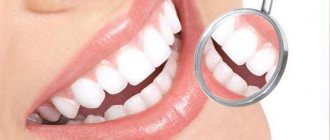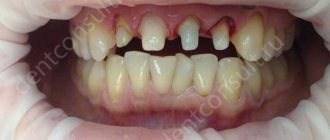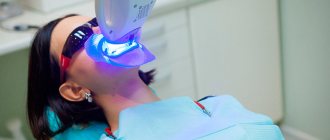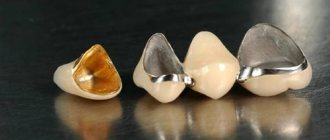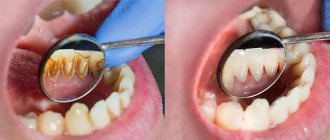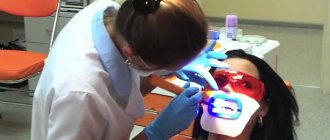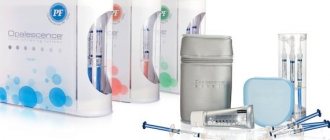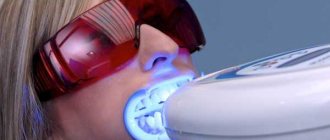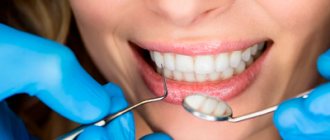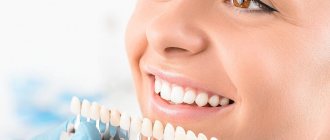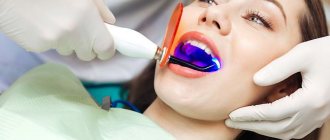Date of publication: 18-01-2019 Date of update: 17-02-2021
Author of the publication: Bogatyreva Radima Muradinova Periodontist
The whitening procedure is often perceived as aesthetic, but it also has many positive properties in terms of health improvement. Sometimes patients refuse a snow-white smile because they are embarrassed to discuss the procedure with a dentist or believe myths from the Internet. In this article you will find answers to the most popular questions about teeth whitening that are asked to dentists at the Clarimed clinic.
When is whitening needed?
Different people have different shades of enamel. This is due to genetics, lifestyle, and the quality of hygiene procedures. Changing the color of teeth can have several reasons:
- insufficient oral care;
- artificial or natural colors contained in food;
- bad habits;
- jaw injuries, some systemic diseases;
- taking medications;
- age-related changes.
If any of these reasons are present in your life, or you simply want to lighten your enamel a few shades to make your smile look healthier and more beautiful, this is an indication for whitening.
Does the procedure have any contraindications?
As with any manipulation in the dental chair, there are contraindications, but not many of them:
- pregnancy and breastfeeding;
- oncological diseases;
- allergies to the drugs used.
All other problems - caries, inflammation of the oral mucosa and gums - are considered relative contraindications. After they are eliminated, bleaching can be done.
Even if you take good care of your teeth, whitening will have the effect of making your smile even more aesthetically pleasing.
Indications and contraindications for ZOOM 4 whitening
Whitening ZOOM 4
This procedure is usually used for the same reasons as other whitening procedures:
- dissatisfaction with the natural shade in the smile area;
- smoker's pigmented coating is a consequence of many years of addiction;
- restoration of uniform color of teeth after braces.
Contraindications to this procedure are also traditional:
- age up to 16 years;
- oncological diseases;
- inflammation of the oral cavity in the acute stage;
- untreated caries;
- regular use of antibiotics and oral contraceptives;
- epilepsy and other neurological disorders;
- allergy to the components of the whitening gel.
Do not forget that ZOOM 4 whitening is a purely cosmetic procedure. Before signing up for a session, you must undergo an examination by a dentist, cure all diseases of the teeth and gums, so as not to provoke complications.
Which teeth should not be whitened?
Whitening is not carried out if there is untreated caries in the oral cavity, exposed tooth necks, or enamel damage. If there are composite fillings, the procedure will give an uneven effect, because the color of inorganic materials is not subject to change. The most correct thing would be to install a temporary filling and carry out whitening before the final restoration of the tooth.
The procedure is also not carried out in the presence of braces due to the unguaranteed and uneven result. Exposure to chemicals on the enamel of hypersensitive teeth is undesirable.
Why classic whitening is not performed in childhood
So what’s wrong with classic professional whitening and why aren’t similar procedures performed in children? The thing is that a child’s tooth enamel is characterized by increased fragility and susceptibility to any kind of external irritants. And traditional methods of lightening it precisely involve a rather aggressive effect on the surface of the teeth. Here are some good reasons that do not allow you to whiten children's enamel even in the dentist's office:
- thinning of the enamel: as a result of exposure to chemicals, ultraviolet radiation or laser, the density of the enamel is noticeably reduced and its structure is disrupted. When it comes to a child, the protective layer of the teeth may not be able to withstand it at all. As a result, the risk of developing caries and other dental diseases greatly increases,
- demineralization: during the procedure, rapid destruction of minerals is observed, and this, in turn, greatly weakens the teeth. Even adult patients after whitening are recommended to undergo a remineralization procedure,
- increased enamel sensitivity: teeth begin to react sharply to hot and cold, as well as to acidic foods, and this is an obvious drawback of professional whitening. The enamel becomes much thinner, which significantly increases the likelihood of problems with teeth and enamel pigmentation in particular.
- risk of burns: using ultraviolet light to lighten tooth enamel can cause a serious burn on the mucous membrane. At the same time, dental tissues also suffer greatly from heating.
Aggressive whitening can lead to thinning and demineralization of the enamel.
Obviously, the only option to make the enamel of children's teeth a little lighter is to schedule a professional cleaning at the dentist's office. If we are talking about a child, then this is the safest and preferable option, which allows you to make the enamel a couple of tones lighter. And remember: independent attempts to lighten children’s teeth using folk remedies are fraught with serious problems, including complete destruction of the enamel. This kind of procedure is best left to professionals.
- According to WHO research results.
How to whiten teeth at home?
All chemical preparations for teeth whitening at home, as well as professional ones, contain peroxide gels. They are applied using different devices:
- mouth guards – “covers” for teeth made of hypoallergenic plastic. They are filled with a special gel and worn for several hours a day;
- adhesive strips - stickers on teeth already impregnated with hydrogen peroxide or urea. A thirty-minute daily procedure will help brighten your smile by one or two shades in just a month;
- whitening gels and pencils - used in the same way as strips.
But Clarimed specialists recommend visiting a dentist before starting home whitening; our clinic even offers a free consultation; don’t risk the health of your teeth.
Are there other ways to get beautiful white teeth besides whitening?
Veneers also help improve the appearance of teeth, including giving them the necessary whiteness. Thin ceramic or composite plates are fixed to the outer surface of the teeth. As a rule, veneers are installed on the front teeth, which are most visible when communicating. Dental clinics offer veneers as one of the fastest, most reliable and effective methods of giving teeth the desired shape and whiteness.
Proper daily dental care after whitening or installation of veneers using dental floss and mouth rinse will significantly prolong the achieved result. A beautiful snow-white smile is guaranteed for a long time!
The most important thing is not to engage in self-medication and “self-whitening” - trust the experienced professionals of the RICA clinic, bring back your bright, clean Hollywood smile.
Is it possible to whiten teeth at home?
Home whitening has a serious limitation - it does not carry risks if it is carried out on absolutely healthy teeth. If the neck of the teeth is exposed, there are cracks in the enamel and carious cavities, such procedures will only cause harm. Before using chemical gels, you should consult your dentist.
Folk remedies that are recommended for whitening are no less traumatic for enamel than professional chemical ones. The use of soda, charcoal, and lemon juice sometimes causes more harm than bad habits or injuries.
How often do you need to perform the whitening procedure to maintain the effect?
Teeth whitening using chemicals changes the condition of the enamel. Therefore, doctors do not recommend performing it more often than once every 2 years. Between procedures it is recommended:
- For the first month, avoid food and drinks with active dyes - red wine, coffee, brightly colored vegetables.
- Quit smoking - nicotine will quickly return the yellowish tint.
- Visit your doctor regularly to get rid of plaque and tartar.
- Use threads, special pastes, and electric brushes in home care.
Tips to help you maintain a snow-white smile
- Eliminate from your diet those foods that are dark in color. We looked at them in more detail in the article about the white diet after teeth whitening;
- Maintain basic oral hygiene (choose a suitable toothbrush, toothpaste and mouthwash, brush your teeth properly);
- Visit your dentist regularly.
Quite often we are told that teeth whitening is a harmful procedure. But there is no need to listen to false rumors. Modern mixtures do not contain hazardous substances at all and practically do not damage the surface of the teeth. If you agree to whitening, you need to visit your dentist regularly to keep your teeth healthy. This procedure can only be carried out if you have completely gotten rid of caries, tartar and filled problem areas. If you follow all the rules of hygiene and listen to the advice of a specialist, then you will not need to whiten your teeth as often, and in return you will get a snow-white and radiant smile.
Are preparatory procedures necessary before lightening tooth enamel?
The process of preparing for teeth whitening takes place in several stages:
- examination of the dentist and identification of absolute and relative contraindications;
- sanitation of the oral cavity and installation of temporary fillings, if necessary;
- removal of tartar, plaque, polishing and fluoridation.
A few weeks before the procedure, it is advisable to start a course of medications to reduce sensitivity and strengthen the enamel. The doctor will recommend special gels and pastes for treating teeth.
At the patient’s request, the dentist will take impressions to make a special mouth guard for subsequent use at home. This will help prolong the effect of the professional procedure.
Carry out the whitening procedure at the Clarimed clinic, we guarantee excellent results
How does non-professional whitening affect tooth enamel?
Frequent and uncontrolled use of chemicals for treating teeth leads to the gradual destruction of enamel. It becomes more porous, absorbs dyes faster, becomes cracked and loses its whiteness. The decrease in mineralization of the outer layer and its destruction can be partially compensated with the help of fluorine-containing preparations.
But provided that the whitening procedure is carried out in a dental clinic, in compliance with the recommendations of the attending physician, all risks and negative consequences will be minimized.
We hope that the whitening procedure is now clearer to you and you are ready to achieve a Hollywood smile. Call or sign up on the website:
We also recommend paying attention to the popular service - installation of veneers - snow-white teeth like superstars!
Pros and cons of ZOOM 4 whitening
ZOOM 4
Advantages of this technique:
- guaranteed enamel lightening by 8-10 tones;
- long-term effect - with proper daily hygiene and a balanced diet, teeth begin to darken no earlier than after 4 years;
- the session lasts 45 minutes, which is 30% faster than the previous generation devices;
- the upper layers of enamel are not destroyed, as with chemical bleaching;
- clinically proven results in patients with advanced fluorosis and tetracycline teeth;
- The device's lamp has a cold halogen light, the risk of gum burns is minimal.
There are not many disadvantages to the procedure:
- an impressive list of contraindications;
- slight likelihood of increased tooth sensitivity after the session;
- if anterior fillings and dentures are installed, they will have to be changed to lighter ones so that they do not stand out;
- high cost of the service.
